Dear Readers, Cobalt Firearm Instruction is a participant in the Amazon Services LLC Associates Program, an affiliate advertising program designed to provide a means for us to earn fees by linking to amazon.com affiliated sites. This post may contain various affiliate links. If you click them and make a purchase, it will not cost you a penny more, however a small commission will be paid to CFI to help keep the lights on. We will NEVER endorse something we do not wholeheartedly believe in, ever. Thanks!
Getting worse the more you shoot?
Perhaps this situation rings a bell for you:
Your target is set up, your gun is loaded, you press off your first shot of the day.. BAM! Bullseye or darn near it.
2nd shot… press on that trigger… BAM! … eh not quite as good as the first, maybe my grip was funny, it’s still a pretty good shot.
3rd shot… press press… BAM! Alright, shake that one off too (it’s further from the bullseye than the 2nd.)
4th shot… grip is locked in, probably harder than usual, jaw is set a little bit here, gun might be shaking a tiny bit from that vice grip you’ve got on it, but you’re going to get that shot back in the bullseye like the first one to prove it wasn’t luck… BAM! “aw what the hell is going on?” (it’s the furthest away yet.)
Sound at all familiar? You aren’t alone. This just means your brain works, congratulations. In my estimation that’s more than a lot of people can say these days.
This weird phenomena of “getting worse the more you shoot” has played out in front of my eyes more times than I can count, always to the frustration and bewilderment of the shooter going through it.
So… what causes it, and what can you do about it?
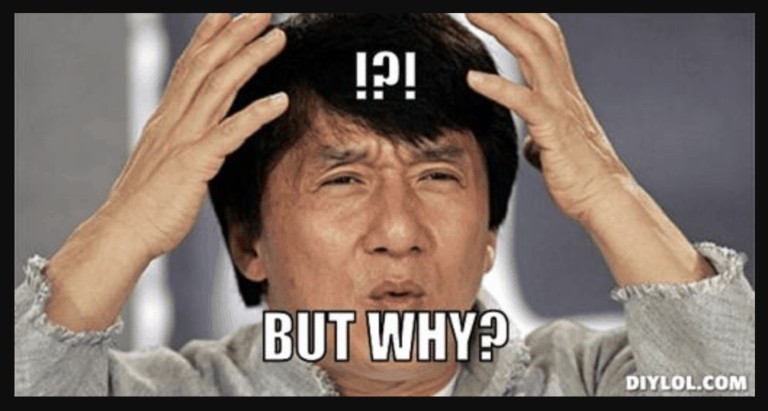
What causes it?
Short answer? Your brain is working how it’s built to work.
Much like a roomba that just vacuumed up your favorite diamond earring that you dropped on the ground, you may not be happy with the results but it’s technically doing what it’s built for.
Stick with me here because I am going to be oversimplifying the ABSOLUTE DAYLIGHTS out of some very complex mental processes. If you geek out on this stuff like me and want to learn more, the book Atomic Habits is a good primer/intro to some of these concepts and if you REALLY want to go for it, leave me a comment or send me a message and I can point you to some even drier research on the subject.
Patterns & Defense.
To make a LONG story almost too short, your brain is on a 24/7 mission to put you on autopilot. It does this to conserve energy and “brain power” so you can focus on what you need to focus on. A very large percentage of what you do every day is done out of habit without having to really think about what you’re doing and this is by design. If you had to truly think about every single thing you do, you’d hardly get anything done, so your brain makes shortcuts for you where you can coast on autopilot.
How does it do this??
By becoming a pattern recognizing machine. Once the brain picks up on a pattern and the needed response, it codes a little shortcut and then you do the thing without having to devote actual brain power to it. Do you have to consciously think about which direction to tie your shoes or how to lock your door or breathe? I doubt it. This mechanism is constantly working in the background to save your brain’s vital focus and your body’s vital resources for what what REALLY counts. It’s absolutely astounding how it works.
This can have some downsides though, notably when it comes to bad habits (shortcuts) we develop along the way.

Example: You’re stressed from a long hard day at work – You drink a glass of wine and relax – your stress goes down. Your brain took itself from a negative space (that of stress) to a positive one, mission accomplished. After 1 or two reps of this, the new shortcut your brain makes is: “Feel stress -> Crave wine” because it knows this is a path that has worked before to alleviate a negative condition. Leave it for too long and the brain makes another shortcut like “Any bad feeling at all -> Crave Wine” Have a fight with your spouse and without thinking or realizing it, you’re in the kitchen uncorking the bottle, no brain power, nutrients or resources needed. This is one of 1,000s of examples we could give for this stuff, your brain is doing it all the time.
Now take that superhuman pattern recognizing ability and put it to work doing something vital like, I don’t know, keeping you from blowing your own face off while handling a deadly weapon, and you’ve got the makings of the reason that you’re missing the bullseye. The pattern looks something like this:
Shooting Example: You’re about to shoot for the first time – you feel the tension in the trigger against your finger as you press it – the gun EXPLODES – you’re scared sh@*&less (or at the very least startled) – the deadly weapon jumps around in your hand like a bronco on hot coals – you squeeze extra tight on the grip – you maintain control and have kept yourself from blowing your face off for at least one more moment. New brain pattern : “Pull Trigger -> Gun goes off -> Big Explosion -> Extra Tight Grip -> Safe from gun.” Do that a couple times and it gets shortened to “Pull Trigger -> Explosion -> Big Squeeze -> Safe”
It doesn’t take long until your brain has hardwired a direct connection between the act of pulling a trigger and the act of locking in your grip super tight to keep you safe and in control (two things your brain very much likes to feel.) This will make you miss, I’ll explain in a moment.
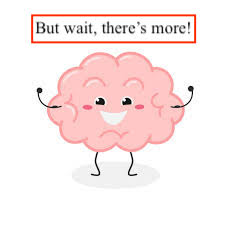
Last but certainly not least, while all this is happening, your brain is realizing that the time you spend pressing the trigger is one of stress and worry (minor as it may be for some, massive as it may be for others.) You’re essentially waiting for a tiny bomb to go off in your hands. Much like a bandaid stuck to arm hair, your brain decides it’s best to get this part (pulling the trigger) over with quickly. Result – by doing essentially what it’s programmed to do, if left unchecked, your brain will have you squeezing that gun super tight in the last second while you yank on that trigger super hard.
Without you even realizing it, your brain’s natural need to protect itself (big squeeze) and aversion to stress (let’s pull that trigger quick and get the bad part over with) have ruined your trigger control. It’s taken what should be a slow, conscious process of pressing the trigger straight back to the rear without moving the gun and turned it into a big squeeze of the entire hand that happens almost too fast for your conscious brain to realize it.
Why is this such a big deal?
Both of those things (big squeeze and fast movement of the trigger) will move the gun around a lot the split second before it goes off. THIS. WILL. CAUSE. YOU. TO. MISS.
If you’re a student, you might be sick of hearing me talk about the importance of trigger control to your shooting so you have my blessing to skip this section if you’d like. If “trigger control” is a new concept to you please read along with me here I’ll keep it short. It’s easiest to show with a quick test, whether you have a gun or not.
At home test (with gun) – Check and then check again that your firearm is entirely unloaded and keep it pointed in a safe direction. Hold it medium firm in your shooting hand. Hold the gun down by your waist, still in a safe direction. Look down at the front sight. Count down from 3 and on 1 squeeze the gun as hard as you can all at once. See how much that sight moved? Yes you did you liar.
At home test (without gun) – Grip a pen in your fist like a caveman would (photographed.) Use a medium amount of grip pressure and hold it LIGHTLY on a piece of paper. Count down from 3 and on 1 squeeze your hand super tight all at once. It likely left a nice line on that paper. Your hand moved more than that line shows but it’s a simple illustration just about anyone can do so it works for our purposes here. Now here’s where things get interesting.
You just proved that when you squeeze your hand super hard it moves a lot, the same applies to anything you may be holding.
The finer points of sight alignment aren’t the point of this article, but suffice it to say, if you’re aimed at the bullseye properly, and you move your front sight even .14″ (yes, that’s less than 1/4 of an inch) out of alignment with your back sights (like I don’t know.. say.. when you squeeze super hard on the gun last second) you will miss by half a foot on a target just 7.5 yds away. Recap: .14″ movement of front sight = 6.5″ miss on the target.
Don’t believe me? The 3rd photo attached is the math proving it (yep, that’s not just a picture of stuff made to look like math, it’s the real math proving it.)
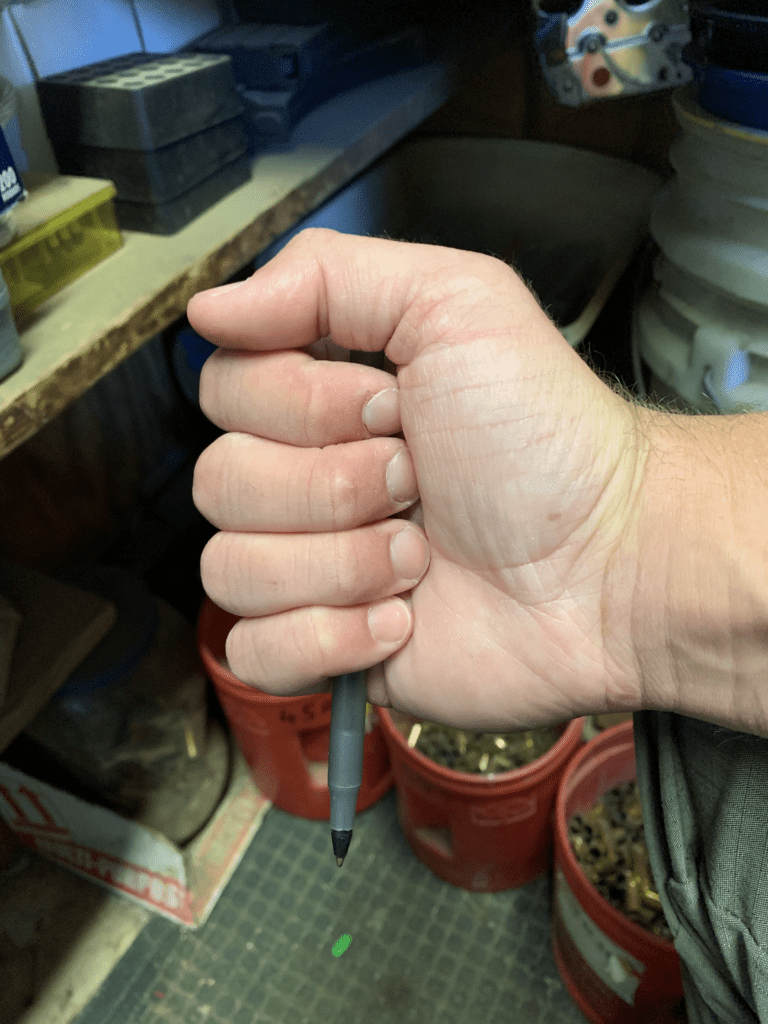
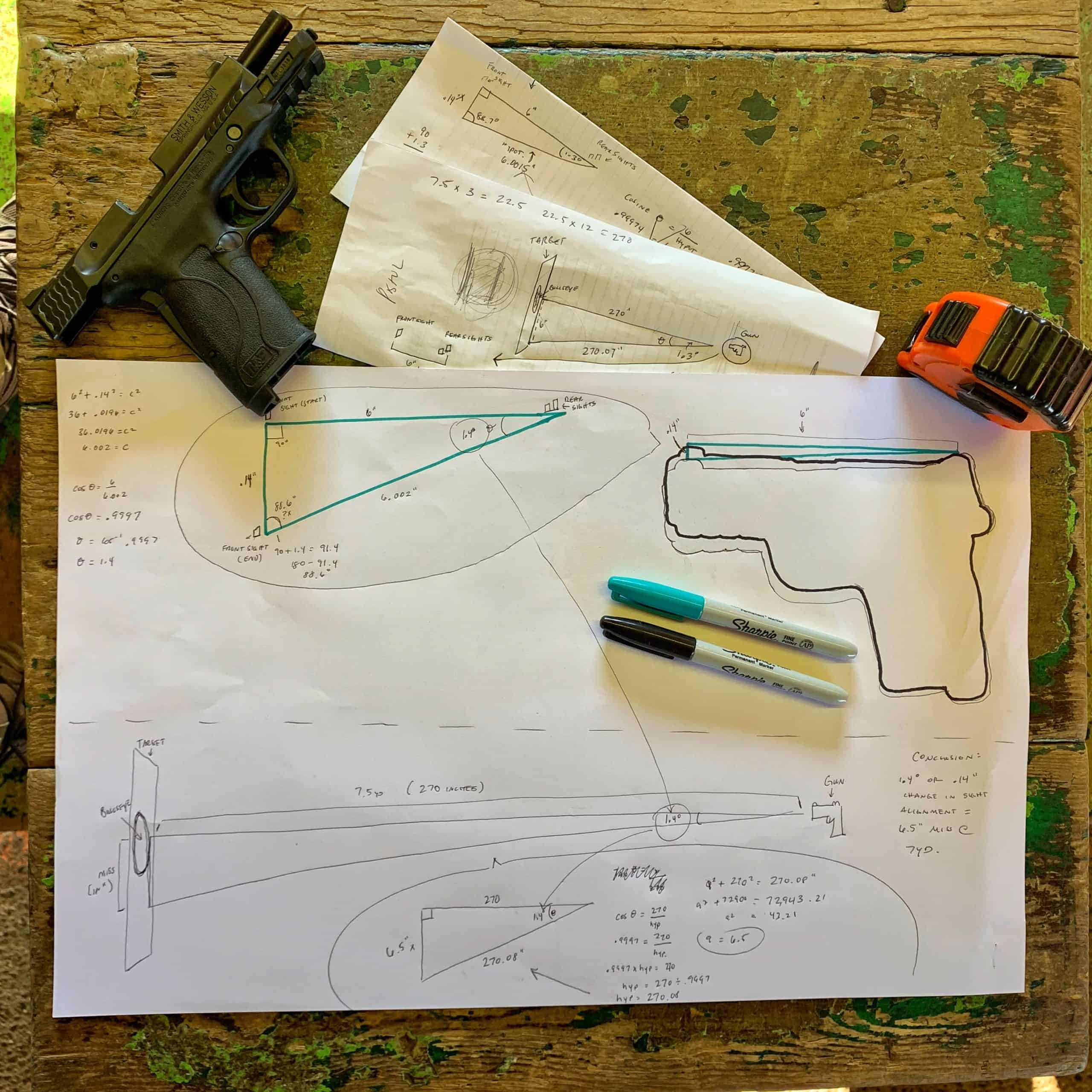
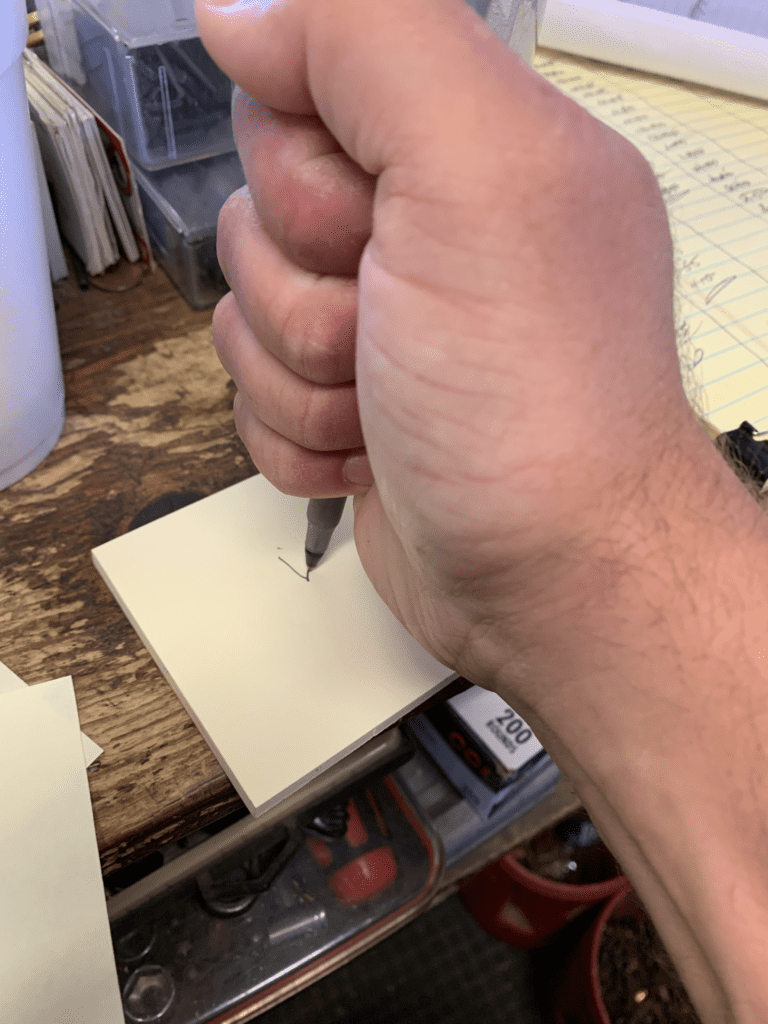
What's that got to do with getting worse while I shoot?
So you’re wondering why your first shot is awesome and then they start going bad? Simple. For your first shot, your brain forgot to screw with what you were doing.
All the craziness we just talked about up there is wired in as a response to a stimulus. When you come back out to the range after a time away, you don’t viscerally remember how it felt to have that gun explode in your hand, at least not the way you did then. You aren’t yet on autopilot just executing hardwired pre-planned responses to stimuli, you have to think about what you’re doing and consciously execute. You are the one in the driver’s seat and all you’ve got to go on is the information you’ve been told by whoever it was who taught you how to shoot.
Hopefully something that sounds like: “focus on your front sight, make sure it is lined up evenly between the two back sights, rest the front sight on the center of your target, touch the trigger, press back until you feel the pressure build on your finger, then slowly add more pressure to ONLY your trigger finger while keeping your sights from moving out of alignment with one another… etc.”
Then the brain gets back involved. It got woken up and reminded of what a crazy task this is. It remembers all its defenses and starts kicking them in. Before you know it you’re back to “why the heck are all these shots going low left I’m aiming at the bullseye” and wondering if you bought some bad ammo in the middle of the pandemic.
Not to worry, the fixes are easy. Not necessarily quick but pretty easy.
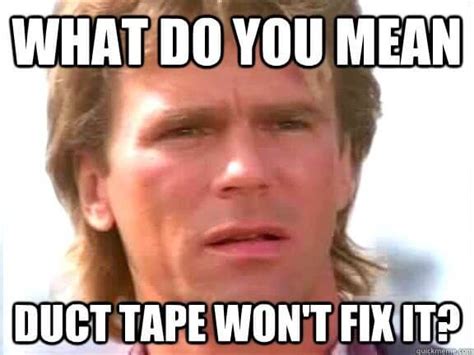
What can you do about it?
How do I fix it?
- Slow Down! – Slowing down everything that you do once you’re aiming at the target will do two things: 1. When you move your trigger finger slower it’s less likely to move the rest of the fingers around it. You can test this right now by holding your shooting hand up next to you like you’re being sworn into office and then moving your index finger super fast, the rest of the fingers moved too didn’t they? Yes they did you liar. Now go as slow as you can and focus on not letting ANY other fingers move. Much easier now. Moving slower recruits less muscles into action thus transferring less movement into the rest of your hand. 2. The slower you go the more in control you remain. Slowing down is one of the best defenses against your brain kicking you into bad-habit autopilot. The slower you go the more you notice about what you do and the more in control you stay.
- Squint – Just try it a couple times for me, would ya? I know it sounds weird but a VERY common thing we see accompanying this slip into “autopilot” like we call it, is eyes CLOSING. You heard right, the eyes close right before the shot. We’ve got video clips of so many students doing it it’s not even funny. When you squint a little bit with your shooting eye(s) it once again sticks you in the drivers seat and can go a long way towards making sure you don’t shut them before the gun goes off, or making you more aware of it if you start to.
- Shoot 1 handed – Keep your eyes open over the next few weeks because I want to gather a bunch of shooters for a study on this very phenomena that we’ve come across in our years teaching. There is a very good chance if you’re dealing with an anticipation flinch, you will shoot as well if not much better when you try shooting 1 handed. There are a few hypothesis we have about why this works but the long and short of what we know thus far is this: At the very least it forces you to focus, the discomfort and extra movement you feel being forced to control the gun with one hand has the effect of making you focus 100% on the task at hand, keeping you more present, and giving you a good look at everything you do wrong when it happens. You work on 1 handed and then bring the control you had shooting 1 handed back to your two handed shooting.
- Dummy Rounds – Mix dummy rounds, or snap caps (pictured & linked below) into your magazines with live ammunition. Dummy rounds help you do what dry fire can’t, bring out the bad habits that only come out when you’re shooting live ammunition. Dry fire is a HUGE part of building the proper fundamentals, but at the end of the day, your brain knows that the gun is not going to go off, which is where these nasty habits & shortcuts come into play. When you pull the trigger on the dummy round the gun will not go off and it will give you a STARK view of just exactly what you’re doing when you pull the trigger. The gun should stay perfectly still, if it doesn’t, you’ve got a good look at your trigger control problems.
- Home Practice – Don’t take what I just said to mean that dry fire practice at home can’t help because it ABSOLUTELY does. Dry fire is free, you don’t have to leave your house or even get out of your PJs. It’s the most cost and time effective way to develop the right fundamentals and muscle memory particularly when it comes to trigger control. You’re spending time building the RIGHT habits so that you have a fighting chance battling the bad ones when they come out on the range.
<- If you click either of those it'll take you right to some stuff I mentioned in the above write ups.
I hope this all helps.
If you’ve got more questions or comments don’t hesitate to reach out and let us know. As always, Stay Smart, Stay Safe, Never Stop Improving.
- Chris Murphy, Owner, Cobalt Firearm Instruction, LLC.

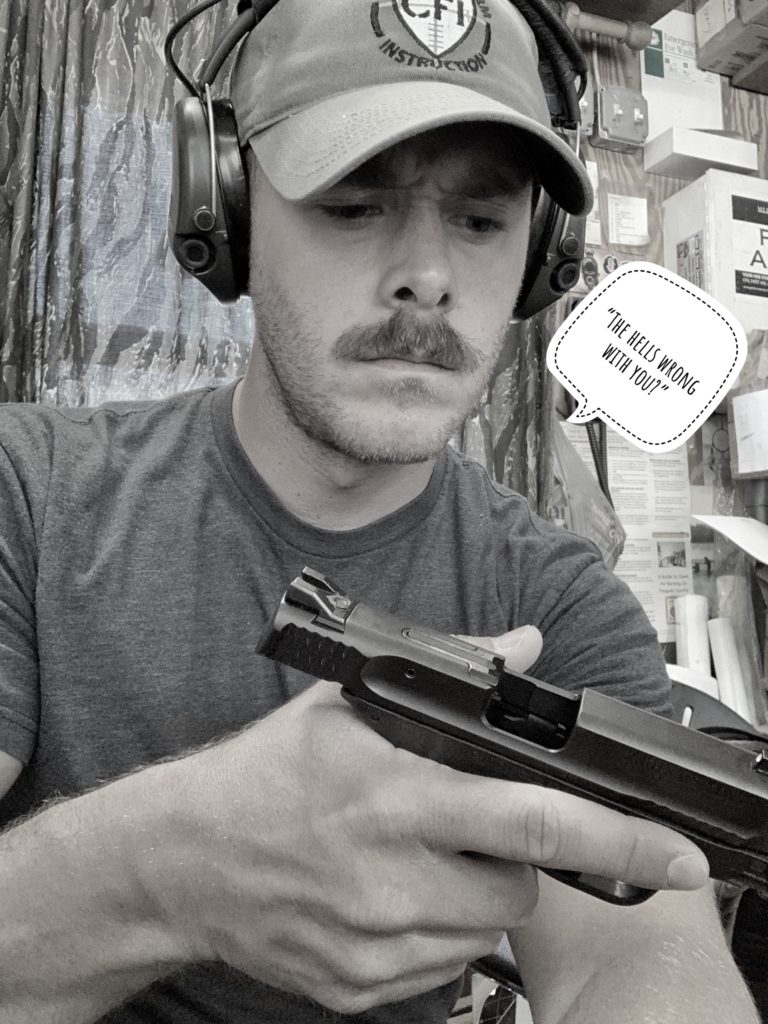
Thanks Chris. Makes sense…now for practice. BTW, the home test sith a pen made a believer out of me!
Thanks!
Thank you for the great article, CFI!